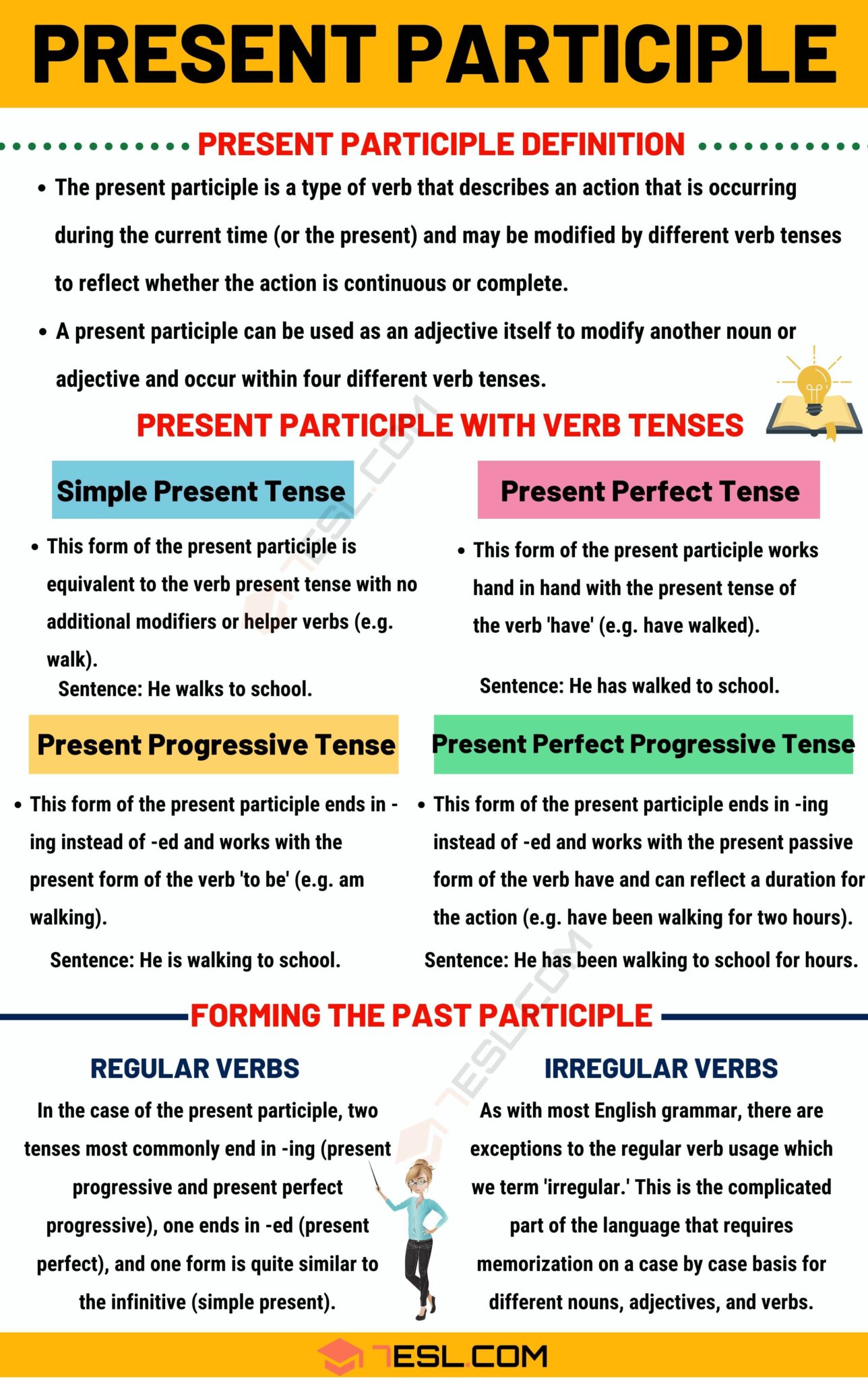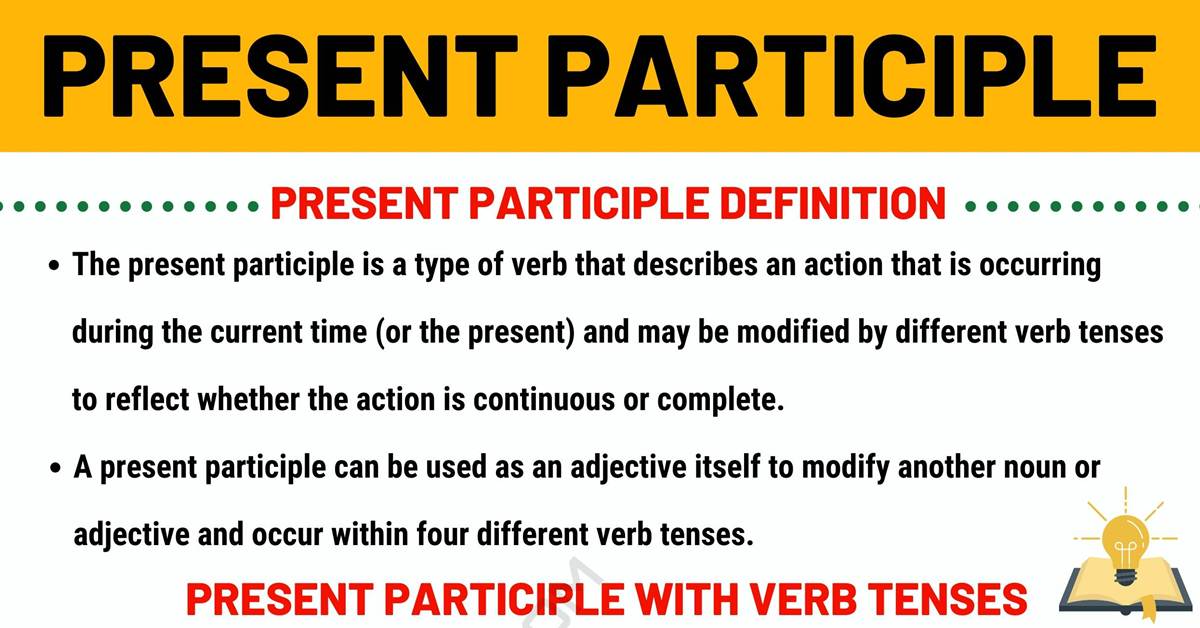In this lesson, you will learn what present participle is and how to use it with verb tenses in English. You also learn how to form the present participle with regular and irregular verbs.
Present Participle
Present Participle Definition
In English, the ‘present participle’ is a type of verb that describes an action that is occurring during the current time (or the present) and may be modified by different verb tenses to reflect whether the action is continuous or complete. The verb can modify a noun, noun phrase, adjective, or adjective phrase. Additionally, a present participle can be used as an adjective itself to modify another noun or adjective and occur within four different verb tenses (as shown below.
Present Participle with Verb Tenses
The present participle can be used to illustrate different points in the timeline by modifying it with different verb tenses: simple present tense, present perfect, present progressive, and present perfect progressive tense.
Simple Present Tense
The simple present tense shows that an action is occurring in the present setting of the story. This form of the present participle is equivalent to the verb present tense with no additional modifiers or helper verbs (e.g. walk).
Present Perfect Tense
The present perfect tense shows that an action started in the past and is still ongoing during the current time. This form of the present participle works hand in hand with the present tense of the verb ‘have’ (e.g. have walked).
Present Progressive Tense
The present progressive tense shows some form of continuing or ongoing activity that is currently occurring in the present but did not necessarily complete. This form of the present participle ends in -ing instead of -ed and works with the present form of the verb ‘to be’ (e.g. am walking).
Present Perfect Progressive Tense
The present perfect progressive tense shows a continuing action that occurred and completed in the past but continues to have some importance in the present time. This form of the present participle ends in -ing instead of -ed and works with the present passive form of the verb have and can reflect a duration for the action (e.g. have been walking for two hours).
Forming the Present Participle
Regular Verbs
In the case of the present participle, two tenses most commonly end in -ing (present progressive and present perfect progressive), one ends in -ed (present perfect), and one form is quite similar to the infinitive (simple present).
Regular verbs form the ‘general’ case for the present participle and most verbs are expected to follow the simple rules described above.
Irregular Verbs
However, as with most English grammar, there are exceptions to the regular verb usage which we term ‘irregular.’ This is the complicated part of the language that requires memorization on a case by case basis for different nouns, adjectives, and verbs. Below is a list of some common irregular verbs and their present participle forms. As you can see, some of them are very close to the infinitive, just as regular verbs are, while others have slight differences.
- Infinitive: to choose
- Present tense: choose
- Present participle: I choose/I am choosing/I have chosen
- Infinitive: to do
- Present tense: do
- Present participle: I do/I am doing/I have done
- Infinitive: to drink
- Present tense: drink
- Present participle: I drink/I am drinking/I have drank
- Infinitive: to eat
- Present tense: eat
- Present participle: I eat/I am eating/I have eaten
- Infinitive: to give
- Present tense: give
- Present participle: I give/I am giving/I have given
- Infinitive: to forget
- Present tense: forget
- Present participle: I forget/I am forgetting/I have forgotten
- Infinitive: to lie
- Present tense: lie
- Present participle: I lie/I am lying/I have lain
- Infinitive: to let
- Present tense: let
- Present participle: I let/I am letting/I have let
- Infinitive: to see
- Present tense: see
- Present participle: I see/I am seeing/I have seen
- Infinitive: to sleep
- Present tense: sleep
- Present participle: I sleep/I am sleeping/I have slept
- Infinitive: to throw
- Present tense: throw
- Present participle: I throw/I am throwing/I have thrown
- Infinitive: to choose
- Present tense: choose
- Present participle: I choose/I am choosing/I have chosen
- Infinitive: to write
- Present tense: write
- Present participle: I write/I am writing/I have written
This list is not meant to be complete but to provide some idea of how to create sentences using some of the most common irregular words in the English vocabulary. Typically, the best way to pick up the oddities of English is by extensive reading with a dictionary at hand to look up unknown words.
Present Participle Examples
Below are several sentences that illustrate how to use a present participle in all the ways noted above.
Regular Verbs
- Verb: to walk
Present Participle: walk/walks
Verb Tense: simple present
Sentence: I walk five times around my office building during my lunch hour all throughout the warm Spring and Summer months.
- Verb: to repair
Present Participle: have/has repaired
Verb Tense: present perfect
Sentence: My son has repaired the chain on his bicycle so many times I have lost count.
- Verb: to travel
Present Participle: was travelling
Verb Tense: present progressive
Sentence: I was travelling home for the holidays when I swear I saw Santa on the wing of the plane…
- Verb: to help
Present Participle: have/has been helping
Verb Tense: present perfect progressive
Sentence: I have been helping my landlady carry in her groceries every week for the last two years.
Irregular Verbs
- Verb: to choose
Present Participle: choose
Verb Tense: simple present
Sentence: I choose to collect stuffed bears even if my friends say it’s ridiculous.
- Verb: to break
Present Participle: have/has broken
Verb Tense: present perfect
Sentence: My son has broken the school record for most goals in soccer two seasons in a row.
- Verb: to give
Present Participle: was giving
Verb Tense: present progressive
Sentence: My wife was giving both her time and money to the local animal shelter because caring for stray dogs was her passion.
- Verb: to lie down
Present Participle: have/has been lying
Verb Tense: present perfect progressive
Sentence: I have been lying down for a nap every afternoon since I turned 45.
Conclusion
By studying the examples in the previous section, it starts to become clear that the present participle is a grammatical structure that is really very common, whether one remembers the name or not. Most of the time it is spoken or written the right way, but it is the irregular verbs that cause the most confusion. It’s a little easier considering the present participle than the past or future participles as the irregular verbs don’t have much variation to recall here and one can rest assured that the general case applies to even more of the irregular verbs…
Present Participle Infographic









0 Comments